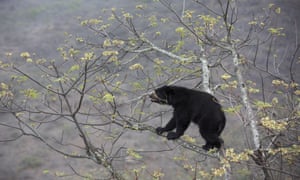Deep in the Maquipucuna cloud forest, two hours drive from Ecuador’s capital, Quito, rare Andean bears come together for a few weeks each year to feast on the wild avocados ripening atop mist-shrouded trees.
According to ecologists, this small community is growing, bucking the trend of a vulnerable species in decline across South America. The gathering, similar to those of grizzly bears at salmon rivers in Alaska and Canada, is turning what experts know about this normally reclusive, solitary creature on its head.
“Throughout the Andes, because of habitat loss, we would expect to see a population in decline,” said Rebeca Justicia, a conservationist and co-founder of the Maquipucuna Foundation and reserve. “But locally we have seen a spike in the population. We are even seeing mothers with cubs, which is very unusual.”
There are believed to be fewer than 10,000 of these bears left across the northern Andes. Listed as vulnerable on the International Union for the Conservation of Nature red list, they face an increasingly uncertain future due to habitat destruction and hunting.
Justicia set up the Maquipucuna Foundation with her husband, Rodrigo Ontaneda, 30 years ago. They were instrumental in persuading many local communities to stop ranching and timber farming and lobbied for protection of the wider Choco–Andino Pichincha region, which was finally declared a Unesco biosphere reserve in 2018.
“When we started our project, it was very hard to see a bear,” said Justicia. “We heard, anecdotally, there were bears here and that people hunted them.”
Andean or spectacled bears, which have earned global attention thanks to the fictional Paddington Bear, are hunted for parts used in the international wildlife trade – gall bladders, used in oriental medicine, can fetch as much as $150 (GBP116) and there is a large market in Ecuador for bear paws.
Justicia spotted her first Andean bear in 2008. Since then, she says, she has recorded 40 different bears, based on photographs taken in the 6,500-hectare (16,061-acre) Maquipucuna reserve, identifying individuals from unique facial markings. Other experts have counted up to 19 bears in the forest in a single year.
“We see an unusually high number of bears during the wild avocado season because they congregate around this abundant source of food,” said Justicia. “The small avocados have very large quantities of fat and oil and that is hard to get in a vegetarian diet. They can come and feed for weeks.”
Little is known about these creatures. Their chosen territory, in dense cloud forest and the high Andes, the fact they may cover up to 10km in a single day, as well as their timid and solitary natures, makes them difficult to study.
But the bear gatherings are helping ecologists understand more about them. Two Andean bears from Maquipucuna, filmed in 2017, were recently featured in BBC’s Seven Worlds, One Planet series, climbing trees to get at the fruit.

“Generally, all bears are solitary,” said Justicia. “The first year we realised this place was different was in 2008. The next year, it went crazy, we saw females with cubs. One February we realised how many bears came together and we began to record them.”
Each Andean bear needs around 1,000 hectares of territory, so the reserve itself would only support six individuals.
Justicia compares the gatherings to those of Alaskan grizzlies that come together at salmon rivers. The bears arrive in the dry months, from September to December, but it is unpredictable, because the avocados do not ripen at the same time every year.
“We still don’t know how the bears decided to come to Maquipucuna,” said Justicia. “But we are learning more and more every year.”
Santiago Molina, a bear expert from San Francisco University of Quito, has carried out his own study of bear numbers in a 65,000-hectare region within the metropolitan district of Quito. His analysis of camera traps has led to an estimate of around 65 bears in the entire region, an area including Maquipucuna but 10 times the size.
Molina is sceptical of the numbers recorded by Justicia, although he recorded 19 bears in the reserve in one season in 2009 and said 15 were spotted within two months in 2017 inside the reserve boundaries.
He is both excited and worried about the rising numbers of what he describes as “Quito’s bears”. The proximity to human populations brings its own dangers.
“This is new,” said Molina, whose work led to the creation of the Andean Bear Corridor, or Corredor del Oso Andino, by the Quito government to protect the bears’ habitat. “It is changing the whole concept of bears. Five years ago, people did not believe there were bears in this area, in the Quito corridor. Before, the bears we studied were in the highlands, the grasslands, not forests, and bears were known to be solitary animals.”
Those bears living in the forest exhibit different behaviour from highland bears, he said. They are known to hunt, dispelling the myth they are mostly vegetarian.
“I have video of a bear hunting a deer – that was a myth for years,” said Molina. “I suspect most of the bears living here have already tasted meat, from feeding on meat left around, for instance when a cow dies. Bears have good scents and are very opportunistic.”
“Now we hear of bear-human conflicts. It is a population under threat,” he added.
He is starting a project in the Yunguilla community, with the international association for bear research and management, to help farmers reduce the chance of bears coming into contact with their cattle and crops.
“We have an opportunity to address this. If we don’t do that we are going to lose the population in the forest.”
Find more age of extinction coverage here, and follow biodiversity reporters Phoebe Weston and Patrick Greenfield on Twitter for all the latest news and features